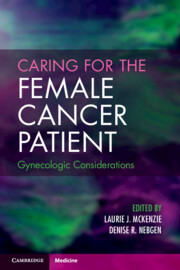Book contents
- Caring for the Female Cancer Patient - Gynecologic Considerations
- Caring for the Female Cancer Patient - Gynecologic Considerations
- Copyright page
- Contents
- Contributors
- Chapter 1 Fertility Assessment and Fertility Preservation Options
- Chapter 2 Abnormal Uterine Bleeding
- Chapter 3 Hereditary Gynecologic Cancer Predisposition Syndromes
- Chapter 4 Managing Sexual Health Through Treatment and Survivorship
- Chapter 5 Premature Ovarian Insufficiency
- Chapter 6 Hormone Therapy and Contraception Management
- Chapter 7 Cervical Cancer Screening
- Chapter 8 Vulvar Lesions and Eruptions
- Chapter 9 Nonpregnant and False-Positive Causes of β-hCG Elevation
- Chapter 10 Cancer and Pregnancy
- Chapter 11 Survivorship Care of Gynecologic Cancer
- Chapter 12 Anal and Colorectal Cancer
- Chapter 13 Bladder Cancer
- Chapter 14 Breast Cancer
- Chapter 15 Cervical Cancer
- Chapter 16 Endometrial Cancer
- Chapter 17 Head and Neck Cancer
- Chapter 18 Leukemia: Acute and Chronic
- Chapter 19 Lung Cancer
- Chapter 20 Pelvic Mass and Ovarian Cancer
- Chapter 21 Thyroid Cancer
- Chapter 22 Vulvar Melanoma
- Index
- References
Chapter 19 - Lung Cancer
Published online by Cambridge University Press: 23 October 2024
- Caring for the Female Cancer Patient - Gynecologic Considerations
- Caring for the Female Cancer Patient - Gynecologic Considerations
- Copyright page
- Contents
- Contributors
- Chapter 1 Fertility Assessment and Fertility Preservation Options
- Chapter 2 Abnormal Uterine Bleeding
- Chapter 3 Hereditary Gynecologic Cancer Predisposition Syndromes
- Chapter 4 Managing Sexual Health Through Treatment and Survivorship
- Chapter 5 Premature Ovarian Insufficiency
- Chapter 6 Hormone Therapy and Contraception Management
- Chapter 7 Cervical Cancer Screening
- Chapter 8 Vulvar Lesions and Eruptions
- Chapter 9 Nonpregnant and False-Positive Causes of β-hCG Elevation
- Chapter 10 Cancer and Pregnancy
- Chapter 11 Survivorship Care of Gynecologic Cancer
- Chapter 12 Anal and Colorectal Cancer
- Chapter 13 Bladder Cancer
- Chapter 14 Breast Cancer
- Chapter 15 Cervical Cancer
- Chapter 16 Endometrial Cancer
- Chapter 17 Head and Neck Cancer
- Chapter 18 Leukemia: Acute and Chronic
- Chapter 19 Lung Cancer
- Chapter 20 Pelvic Mass and Ovarian Cancer
- Chapter 21 Thyroid Cancer
- Chapter 22 Vulvar Melanoma
- Index
- References
Summary
Lung cancer has emerged as a distinct disease in women, and women have unique risk factors as compared to men. Women are more likely to be diagnosed at a young age with adenocarcinoma, lack a significant smoking history and carry driver mutations. Current screening guidelines center around tobacco use, so health care disparities related to gender may impact those women who never smoked and/or prone to lung cancer from distinct etiologies. Molecular and immune markers are important in the workup for cancer, and new treatments with targeted and immune-mediated therapies are available. Women diagnosed with lung cancer have improved survival rates compared to men even while accounting for stage of diagnosis, age, smoking history and treatment modality. Lung cancer survivorship issues can contribute to significant symptom burden, and these can include cancer-related fatigue, reproductive issues, sexual health and sleep disruption. The impact of lung cancer and its’ therapies can affect quality of life especially when treatment-related complications are persistent.
Keywords
- Type
- Chapter
- Information
- Caring for the Female Cancer PatientGynecologic Considerations, pp. 331 - 345Publisher: Cambridge University PressPrint publication year: 2024

